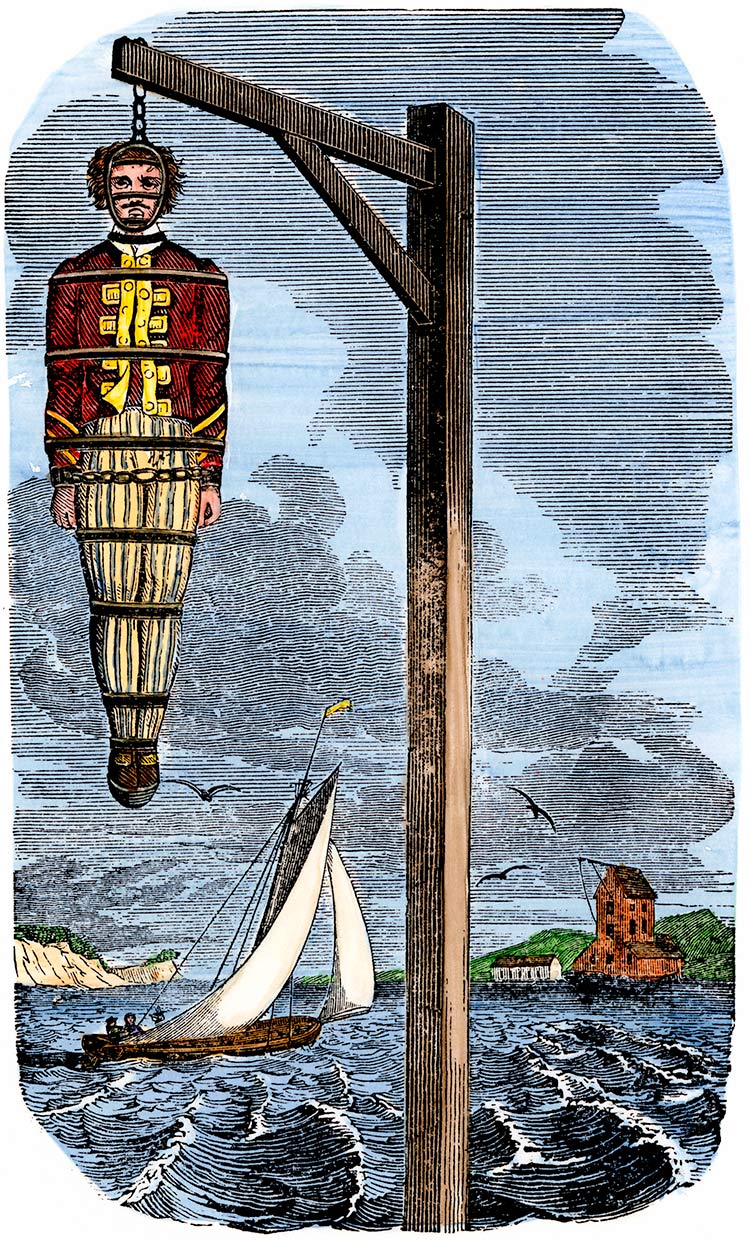Execution of Captain Kidd
The pirate William Kidd was executed in London on 23 May 1701.

William Kidd spent his last days on earth in Newgate Gaol, where on Sunday 18 May 1701, he heard his final sermon, preached by the prison chaplain on the cheerful text, ‘For we must all appear before the judgment seat of Christ.’ Kidd still hoped for a reprieve, and the others who had been condemned with him for piracy received it – all except one, an Irishman named Darby Mullins. On the afternoon of 23 May, they were taken, with two Frenchmen who were also to die, from Newgate in two horse-drawn carts, guarded by marshals and led by the Admiralty Marshal and the silver oar which was the Admiralty’s symbol. To the chaplain’s shocked disapproval, Kidd was the worse for drink. At five o’clock, low tide, they reached Execution Dock at Wapping, a few yards below Wapping Old Stairs, in the presence of a large and lively crowd. There was a permanent gallows for pirates there and after the hanging the corpses were customarily chained to a post on the foreshore, where they were left until three tides had flowed over them, as an example.
Kidd spoke to the crowd, warning all ship-masters to learn from his fate. Then the four men were turned off, but Kidd’s rope snapped and he fell to the ground with the noose round his neck, still alive and dazed. The pestering chaplain prayed over him once more and he was hoisted up again, and that was that. His body was taken to be hanged in chains at Tilbury Point.
Kidd was in his mid-fifties when he died. The line between piracy and government-sponsored privateering was narrow and he does not seem to have been the typical swashbuckling pirate of popular fiction. He did not maroon anyone or make people walk the plank, but legends clustered round him which turned him into a name to conjure with. A Scot by birth, from Greenock on the Clyde and according to tradition the son of a Presbyterian minister, he emerges into history in 1689 as a buccaneer in the Caribbean. A doughty fighter, a fine seaman and evidently a man of some presence, he turned into a privateer captain in British service, sent to pillage French settlements in the West Indies. He acquired a well-to-do wife and property in New York City.
Kidd was in London in 1696, when he set off on the voyage that was to be his undoing. He left Deptford in February in his ship Adventure Galley of 287 tons and 34 guns – probably a cross between a sailing ship and an oared galley – with a government commission to suppress pirates in the Indian Ocean. It took him almost a year to reach Madagascar and the East African coast and he then thought it more profitable to turn pirate himself. Hoisting the blood-red flag, or French colours when it suited him, he captured several merchant ships and in a furious rage when his crew were on the verge of mutiny, he struck his ship’s gunner, William Moore, with an iron-bound bucket, ‘laying him in his gore’ as the popular ballad had it. Moore’s skull was fractured and he died within twenty-four hours.
In January 1698 Kidd seized a valuable ship of 400 tons, the Quedah Merchant, on her way from Bengal round the southern tip of India, carrying silk, muslin, calico, sugar and opium. A substantial part of the cargo belonged to one of the Mughal Emperor’s courtiers and there were Armenian merchants on board. With what was now his own little flotilla, Kidd presently sailed for the West Indies, arriving in April 1699 to discover that the government had proclaimed him a pirate. He left the Quedah at the island of Hispaniola, where she was unloaded and subsequently burned, bought a small ship called the Antonio and sailed to Boston, where he tried to convince the British governor, the Earl of Bellomont, that he was innocent of the accusations against him. Bellomont had him arrested and sent back to England, where on 16 April 1700, it was recorded that ‘the notorious pyratt’ was examined before the Lords of Admiralty and committed to Newgate. Later in the month rumour had it that jewels found on Kidd’s ship had been valued at £30,000 (perhaps equivalent to some £10 million today). After further lengthy enquiries by the Admiralty, on 8 and 9 May 1701, at the Old Bailey Kidd was tried for the murder of Moore and on multiple counts of piracy, and found guilty. Nine members of his crew were in the dock with him on the piracy charges. Whether the evidence was convincing and the trial fair has been debated ever since.
Kidd became a legendary figure largely because no one ever discovered what had happened to the rest of his treasure – if there really was any more to be found. Its value multiplied as time went by and treasure-hunters have searched for his loot from the Americas to the South China Sea, but so far in vain.






